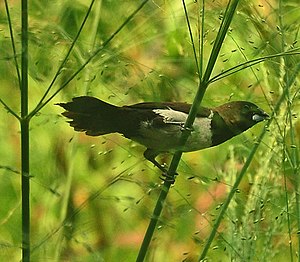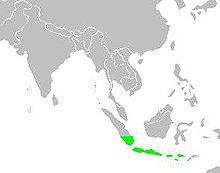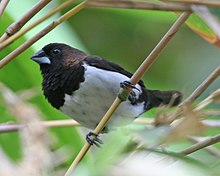Java bronze males
| Java bronze males | ||||||||||||
|---|---|---|---|---|---|---|---|---|---|---|---|---|

Java bronze male ( Lonchura leucogastroides ) |
||||||||||||
| Systematics | ||||||||||||
|
||||||||||||
| Scientific name | ||||||||||||
| Lonchura leucogastroides | ||||||||||||
| ( Horsfield & Moore , 1856) |
The Java bronze male ( Lonchura leucogastroides ), also called black rump bronze male , is a species of the finch family . No subspecies are distinguished. The IUCN classifies the species as not endangered (“least concern”).
description
The Javabronzemännchen reaches a body length of about eleven centimeters and is thus one of the medium-sized splendid finches. There is no sexual dimorphism .
The front head, throat, and front chest are black in both sexes. The top of the head, the sides of the neck, the back and the wing covers are earth brown. The rear rump and the upper tail-coverts are dark brown. The wings are also dark brown and the tail is black brown. The underside of the body is predominantly white: only the rump area and the under tail cover are brown. The German name Schwarzbürzelbronzemännchen, which is used especially in older literature, is therefore somewhat misleading. The back of the body, on the other hand, is blackish.
The young birds lack the black on the head and front neck. They are brown on the upper side of the body and clearly show light shaft stripes. On the underside of the body, they are beige to creamy white.
Distribution area and habitat
The distribution area of the Javabronzemännchen is the south of Sumatra as well as the islands of Java , Bali and Lombok . The Javabronzemännchen is naturalized in the region of Singapore . It is also possible that the Javanese bronze males in southern Sumatra and on the island of Lombok are captive refugees .
The habitat of the Java bronze male is open grass and scrubland. Here it can be seen on the ground as well as in the canopy of trees. The species has also developed habitat for human settlement and is often found on cultivated land and in gardens. The altitude distribution extends up to 1,500 meters above sea level, but this fine finch species occurs mainly at lower altitudes.
Way of life
Javanese bronze males live in pairs or in small societies. The diet consists mainly of grass seeds and other seeds. They also eat rice. Most of the food is taken up on the ground.
The vocal touch sounds are high and are reproduced onomatopoeically with pi-i, pii-it or tie-e . They also call chi-ii with a chirp . The singing resembles other types of bronze men, with a particularly high resemblance to that of the pointed-tail bronze man .
In Java and Bali, the Java bronze male breeds in all seasons. The nest is mostly high in forks of branches or palm whorls. The clutch usually consists of four to five eggs, which are white-skinned. Both parent birds are involved in the breeding business. The breeding season is about thirteen days. There is no uniform information about the nestling time. Both eighteen to twenty and twenty to twenty eight days have been observed in captive birds. Disturbances in youth development may have led to the unusually long nestling period of twenty-eight days. However, observation errors cannot be ruled out either. With 35 to 38 days of life the young birds are independent. They then usually form a flock with other young birds. The juvenile moult begins at six weeks of age and is completed at twelve weeks.
attitude
The date of the first importation of Javanese bronze males can no longer be reconstructed, but they seem to have arrived in Europe very early, as in 1879 they were described as a species that was occasionally commercially available. Until the end of the Second World War, they were only occasionally put on the market. Today they are imported into Europe in small numbers by various importers. Very few keepers breed this species regularly.
supporting documents
literature
- Jürgen Nicolai (Ed.), Joachim Steinbacher (Ed.), Renate van den Elzen, Gerhard Hofmann: Prachtfinken - Australia, Oceania, Southeast Asia. Eugen Ulmer Verlag, Stuttgart 2001, ISBN 3-8001-3249-4 .
- Peter Clement , Alan Harris, John Davis: Finches and Sparrows. An Identification Guide. Christopher Helm, London 1993, ISBN 0-7136-8017-2 .
Web links
- BirdLife factsheet
- Lonchura leucogastroides inthe IUCN 2013 Red List of Threatened Species . Listed by: BirdLife International, 2012. Retrieved October 9, 2013.



